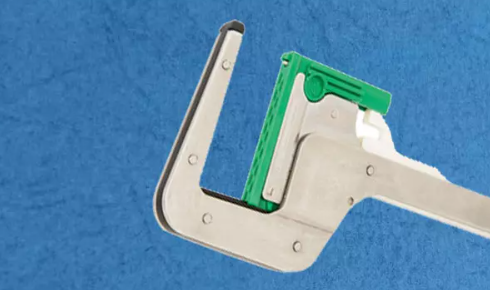The basic working principle of surgical staplers: the working principle of various surgical staplers is the same as that of staplers.They implant two rows of cross-stitched staples into the tissue, and suture the tissue with double rows of cross-stitched staples, which can be tightly Closely suture the tissue to prevent leakage; because small blood vessels can pass through the gap of B-type staples, it does not affect the blood supply of the suture site and its distal end.
Advantages of surgical staplers:
1. The operation is simple and fast, which greatly shortens the operation time;
2. The medical stapler is accurate and reliable, can maintain good blood circulation, promote tissue healing, effectively prevent leakage, and significantly reduce the incidence of anastomotic leakage;
3. The surgical field of suturing and anastomosis is narrow and deep;
4. Change manual open suture or anastomosis to closed suture anastomosis to reduce the risk of using disposable surgical staplers to contaminate the surgical field during digestive tract reconstruction and bronchial stump closure;
5. Can be sutured repeatedly to avoid blood supply and tissue necrosis;
6. Make endoscopic surgery (thoracoscopy, laparoscopy, etc.) possible.Video-assisted thoracoscopic and laparoscopic surgery would not be possible without the application of various

endoscopic linear staplers.
Surgical Stapler Market - Global Industry Analysis, Size, Share, Growth, Trends
Increasing number of surgical procedures due to increasing prevalence of chronic diseases will drive the surgical staplers market over the forecast period. Growth will be driven by rising demand for minimally invasive procedures owing to associated shorter recovery and hospital stays.The stapler allows the surgeon to fix internal wounds endoscopically without the need for an open surgical procedure.Sutures traditionally used for wound closure are prone to leakage and separation, thus increasing choice of staplers over sutures will drive demand. Moreover, issues related to suture healing paves the way for the development of surgical staplers.Technological advances across numerous scientific disciplines have produced many unique surgical devices and instruments used during surgery.The constant introduction of new devices and continued technological improvements to existing devices are changing the way surgeons perform traditional tasks and enabling them to develop new surgical techniques to improve patient outcomes.An unintended consequence of these rapid technological advances has been the creation of a collective "knowledge gap" in surgeons' understanding of how devices interact with tissue.In many cases, surgeons may understand neither the scientific/clinical basis for optimal use of these devices nor how to best utilize the unique complexities inherent in a particular device.As a result, surgeons may often rely on their own experience, exercise their own judgment, or rely on anecdotal evidence, which can translate into suboptimal patient outcomes, even when the device itself is functioning properly.
A surgical stapler is an example of a device that is commonly used in surgery and, at the same time, it is in a nearly constant state of development.Despite the versatility and efficiency of these devices,there is substantial evidence that thread leakage has occurred leading to postoperative complications,often caused by nonischemic problems. Among these, technical errors may play an important role, potentially increasing the risk of bleeding, blood transfusions, and unplanned proximal diversions, especially in gastrointestinal procedures.Many surgeons are unaware of the tissue-handling characteristics and limitations of new or redesigned staplers, so there are knowledge gaps that can affect the clinical outcome of the operation.The advantages offered by surgical staplers, such as greater speed and accuracy and uniformity of wound closure, will be a high-impact rendering factor.The technique also has a lower risk of infection and tissue reactions than sutures.Technological advancements such as the development of products that provide real-time feedback and automated responses to real-time data will increase adoption.Surgeons from general surgery, thoracic surgery, urology, obstetrics and gynecology departments use Linear Cutter and Reload to cut the digestive tract, lung tissue, fallopian tube broad ligament, ileal bladder, etc., and suture bilateral resection margin tissues at the same time, such as sleeve stomach resection and lung wedge resection.It can also be used for side-to-side anastomosis of the digestive tract, such as gastrojejunostomy
Reliability
● The 55 and 75 mm devices have three interchangeable blue, yellow, and green cartridges to suture different thicknesses of tissue.
● The tissue fixation needle prevents the tissue from slipping off from the distal end, ensuring effective cutting and length anastomosis.
● Protruding cam mechanism helps establish parallel closure, ensuring uniform compression of tissue and uniform staple build height.
● Safety device prevents misfire when empty cartridges are reloaded.
● Box cover prevents staples from accidentally slipping out during transport.
● The suture line is 1.5 times the staple width longer than the cutting line to ensure that the end of the cutting line is fully anastomosed to prevent bleeding.
Simplicity
The middle position of the movable handle, one-handed operation, can precisely adjust the cutting and stapling position.Individually wrapped cartridge reloads avoid waste.
Post time: Nov-23-2022





